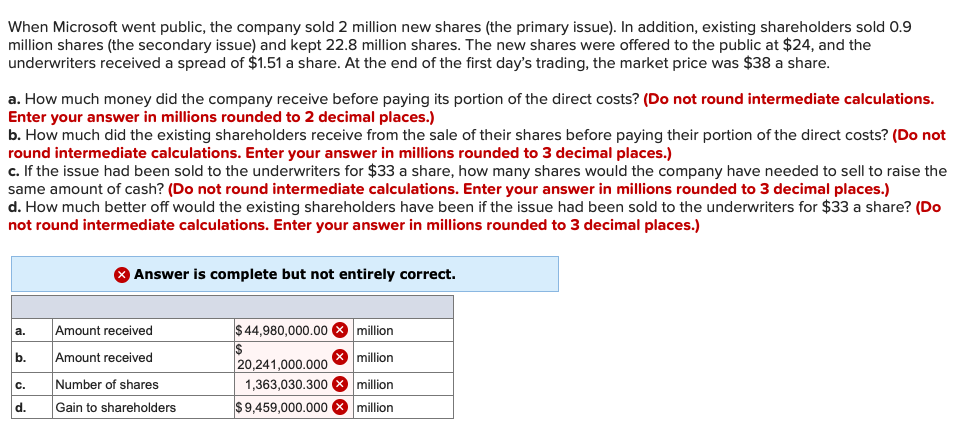When Microsoft went public, the company sold 2 million new shares (the primary issue). In addition, existing shareholders sold 0.9 million shares (the secondary issue) and kept 22.8 million shares. The new shares were offered to the public at $24, and the underwriters received a spread of $1.51 a share. At the end of the first day's trading, the market price was $38 a share. a. How much money did the company receive before paying its portion of the direct costs? (Do not round intermediate calculations. Enter your answer in millions rounded to 2 decimal places.) b. How much did the existing shareholders receive from the sale of their shares before paying their portion of the direct costs? (Do not round intermediate calculations. Enter your answer in millions rounded to 3 decimal places.) c. If the issue had been sold to the underwriters for $33 a share, how many shares would the company have needed to sell to raise the same amount of cash? (Do not round intermediate calculations. Enter your answer in millions rounded to 3 decimal places.) d. How much better off would the existing shareholders have been if the issue had been sold to the underwriters for $33 a share? (Do not round intermediate calculations. Enter your answer in millions rounded to 3 decimal places.) Answer is complete but not entirely correct. Amount received Amount received Number of shares Gain to shareholders a. $44,980,000.00 0 million b. million 20,241,000.000 1,363,030.300 O million $9,459,000.000 O million с. d.
When Microsoft went public, the company sold 2 million new shares (the primary issue). In addition, existing shareholders sold 0.9 million shares (the secondary issue) and kept 22.8 million shares. The new shares were offered to the public at $24, and the underwriters received a spread of $1.51 a share. At the end of the first day's trading, the market price was $38 a share. a. How much money did the company receive before paying its portion of the direct costs? (Do not round intermediate calculations. Enter your answer in millions rounded to 2 decimal places.) b. How much did the existing shareholders receive from the sale of their shares before paying their portion of the direct costs? (Do not round intermediate calculations. Enter your answer in millions rounded to 3 decimal places.) c. If the issue had been sold to the underwriters for $33 a share, how many shares would the company have needed to sell to raise the same amount of cash? (Do not round intermediate calculations. Enter your answer in millions rounded to 3 decimal places.) d. How much better off would the existing shareholders have been if the issue had been sold to the underwriters for $33 a share? (Do not round intermediate calculations. Enter your answer in millions rounded to 3 decimal places.) Answer is complete but not entirely correct. Amount received Amount received Number of shares Gain to shareholders a. $44,980,000.00 0 million b. million 20,241,000.000 1,363,030.300 O million $9,459,000.000 O million с. d.
Financial Accounting
14th Edition
ISBN:9781305088436
Author:Carl Warren, Jim Reeve, Jonathan Duchac
Publisher:Carl Warren, Jim Reeve, Jonathan Duchac
Chapter13: Corporations: Organization, Stock Transactions, And Dividends
Section: Chapter Questions
Problem 4CP
Related questions
Question

Transcribed Image Text:When Microsoft went public, the company sold 2 million new shares (the primary issue). In addition, existing shareholders sold 0.9
million shares (the secondary issue) and kept 22.8 million shares. The new shares were offered to the public at $24, and the
underwriters received a spread of $1.51 a share. At the end of the first day's trading, the market price was $38 a share.
a. How much money did the company receive before paying its portion of the direct costs? (Do not round intermediate calculations.
Enter your answer in millions rounded to 2 decimal places.)
b. How much did the existing shareholders receive from the sale of their shares before paying their portion of the direct costs? (Do not
round intermediate calculations. Enter your answer in millions rounded to 3 decimal places.)
c. If the issue had been sold to the underwriters for $33 a share, how many shares would the company have needed to sell to raise the
same amount of cash? (Do not round intermediate calculations. Enter your answer in millions rounded to 3 decimal places.)
d. How much better off would the existing shareholders have been if the issue had been sold to the underwriters for $33 a share? (Do
not round intermediate calculations. Enter your answer in millions rounded to 3 decimal places.)
Answer is complete but not entirely correct.
a.
Amount received
$ 44,980,000.00 X million
b.
Amount received
X million
20,241,000.000
Number of shares
1,363,030.300 X million
c.
d.
Gain to shareholders
$9,459,000.000 X million
Expert Solution
This question has been solved!
Explore an expertly crafted, step-by-step solution for a thorough understanding of key concepts.
This is a popular solution!
Trending now
This is a popular solution!
Step by step
Solved in 3 steps with 2 images

Knowledge Booster
Learn more about
Need a deep-dive on the concept behind this application? Look no further. Learn more about this topic, finance and related others by exploring similar questions and additional content below.Recommended textbooks for you

Financial Accounting
Accounting
ISBN:
9781305088436
Author:
Carl Warren, Jim Reeve, Jonathan Duchac
Publisher:
Cengage Learning

Intermediate Financial Management (MindTap Course…
Finance
ISBN:
9781337395083
Author:
Eugene F. Brigham, Phillip R. Daves
Publisher:
Cengage Learning

EBK CONTEMPORARY FINANCIAL MANAGEMENT
Finance
ISBN:
9781337514835
Author:
MOYER
Publisher:
CENGAGE LEARNING - CONSIGNMENT

Financial Accounting
Accounting
ISBN:
9781305088436
Author:
Carl Warren, Jim Reeve, Jonathan Duchac
Publisher:
Cengage Learning

Intermediate Financial Management (MindTap Course…
Finance
ISBN:
9781337395083
Author:
Eugene F. Brigham, Phillip R. Daves
Publisher:
Cengage Learning

EBK CONTEMPORARY FINANCIAL MANAGEMENT
Finance
ISBN:
9781337514835
Author:
MOYER
Publisher:
CENGAGE LEARNING - CONSIGNMENT

Principles of Accounting Volume 1
Accounting
ISBN:
9781947172685
Author:
OpenStax
Publisher:
OpenStax College
